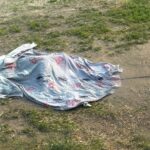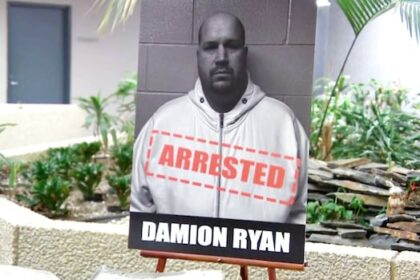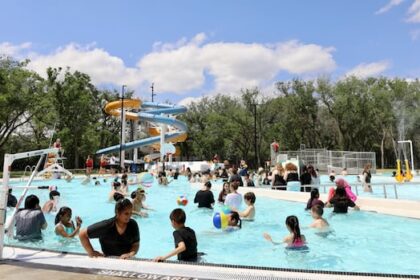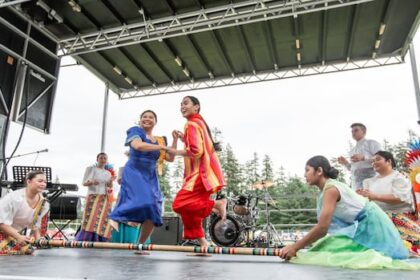Lynn Jacobs opens a gate to the backyard of her small homestead, taking slow strides towards a paddock. “Hey Eddie,” she says sweetly to one of the few goats who rushes the fence line. He softly bleats a greeting back, as a chicken and sheep appear from a wooden shelter. Just when you think it’s over, ducks waddle their way out of the same shelter and towards puddles formed by last night’s rain. This home can be described as a sanctuary for Jacobs, her family, and their livestock. But the land where it sits, she calls something different. “Kahnawà:ke is a fenceline community,” Jacobs tells APTN Investigates. Fenceline (or frontline) communities are residential areas that sit next to high polluting facilities that emit pollutants like noise, light, odours, chemicals, and even traffic. She explains that less than a kilometer from her home and across from the Kahnawà:ke Survival (High) School are waste management facilities, including one that recycles plastic battery casings. “In the summer, we smell plastic burning odours because the process of the recycling is, it gets shredded and it’s heated” says Jacobs. The Kanien’kehá:ka (Mohawk) community is located on the South Shore near Montreal, Que. For Jacobs, growing up here meant facing the impacts that come with living in close proximity to both industrial and commercial development. It also meant witnessing movements to defend and protect land rights, like the Kanesatake Resistance, also known as the Oka Crisis. Driven by this upbringing, Jacobs has spent the past 20 plus years working on environmental issues. ‘It has basically colonized the entire planet, the microplastics, and it has turned all of us into sacrifice zones,” says Lynn Jacobs. Photos: Tom Fennario/APTN. After serving her community as the director of the Environment Protection Unit, the Kanien’keha:ka mother and wife recognized another calling. “I left that work to do some different things a couple of years back, focusing more on the international work in biodiversity and plastics,” says Jacobs. Her refocusing led her to start a PhD at McGill, where she studies plastics and colonialism. She says it’s because there is a lack of Indigenous organizations that are currently working on the issues related to plastics. “I wanted to look at how the plastics are impacting Indigenous peoples at every stage of the plastic life cycle,” she says. With plastics being found in unimaginable places, including the stomachs of fish and even in remote lakes of Northwestern Ontario, Jacobs says that there is a growing realization that this problem is much bigger than litter. “It has basically colonized the entire planet, the microplastics, and it has turned all of us into sacrifice zones,” says Jacobs. Sacrifice zones can be defined as pollution hotspots, where marginalized communities (low-income; people of colour) living next to industry are exposed to extreme levels of environmental contamination. However, Jacobs describes sacrifice zones as a place where government and industry has determined a place and the people living there as disposable. Industry and its historical scars A refinery next door to Aamjiwnaang First Nation. The area is also known as Chemical Valley. Photo: Tom Fennario/APTN. A little over 800 km southwest of the Mohawk territory sits a notorious sacrifice zone: Chemical Valley. Located outside of Sarnia, Ontario the Valley is situated between two of the Great Lakes. The industrial landscape is made up of about 60 large petrochemical, polymer, oil-refining and chemical facilities. But at the heart of it sits one of the last remaining parcels of untouched forest in that region. It has belonged to Aamjiwnaang First Nation since time immemorial. For the approximately 900 Chippewa who live here, this is a place where the community comes together to practice their culture, including language, hunting, gathering, and ceremony. Band Councillor CJ Smith-White is one of many community members who grew up and still live in Aamjiwnaang. “There’s many things I like to do here. The top ones are probably hunting and fishing, as you can tell by my Bushman haircut,” he laughs when pointing to his short but untamed hair. Smith-White knew early on in his life that he wanted to protect animals and the land. For the past three years, he has served as chair of the Environmental Committee, advocating on behalf of environmental justice for Aamjiwnaang. And just like Jacobs, Smith-White agrees that looking at the whole life cycle of plastics is not only important but necessary. “There’s communities that are affected by the extractions, there’s communities affected by pipelines that run and bring those products to the supply chain, which would be here in Aamjiwnaang,” says Smith-White. When asked if he considers his home a sacrifice zone, he answers by saying it’s a loaded question, mostly because of his deep admiration for the beauty that still exists. “I think the short answer is yes, because of historic events that have happened here. We have over 100 years of industry around our nation, which means 100 years of potential mistakes, potential leaks,” he says. The history that Smith-White speaks of is reduced to a simplified narrative on a plaque that is located only 900 metres from the band office. In short, the plaque states that in 1942, a Crown corporation called Polymer Corporation began producing synthetic rubber for World War II. As the industry grew, so did the workforce. Temporary residences eventually gave way to permanent homes, forming what became known as the Village of Blue Water. While housing and services were improved, the village was ultimately disbanded in 1966 due to health and safety concerns, and all residents were relocated. “When this was promised by Polymer, when they were attracting industry, that they would have tax breaks, they would promise lands, they would (promise) little to no regulations. And they created the machine of what we see today,” says Smith-White. Road to redemption ‘We need to really stick together as First Nations peoples to bring forward our issues on plastics,” says Smith-White. Photo: Tom Fennario/APTN. Driving with Smith-White through Aamjiwanaang offers a holistic understanding of what it’s like to live as a fenceline community. As he pulls off the main stretch of pavement and onto a dirt road, he stops to point out areas where past benzene leaks have happened – unaware if it’s been resolved. He draws attention to the fact that the road we are on belongs to Aamjiwnaang and the land on either side belongs to industry. “I mean we still have a little section of it that goes through here. Mind you that there is a pipeline under us as well where we’re parked right now,” Smith-White says. Pipelines snake their way through Aamjiwnaang, transporting products from one industry to the next. One chemical of concern being transported through these lands is benzene, a known human carcinogen. This cancer-causing chemical is used in the making of single-use plastic items like takeout containers. And in Aamjiwnaang, benzene has been a cause for concern long before O’gimaa Janelle Nahmabin declared a state of emergency in April 2024. “The facility that has announced their closure was a plastic facility, and that impacted me my whole entire life. I went to daycare right across the street from there. Now it’s outside the chief’s office window,” says Nahmabin. After serving three terms on the Environment Committee, Nahmabin has been elected as O’gimaa, the Anishinaabemowin word for chief. One of her first orders of business was to declare a state of emergency due to high benzene levels. This happened at the same time Nahmabin was in Ottawa for the fourth round of negotiations for a Global Plastics Treaty. “When we had to call for a state of emergency, there’s a lot people that got sick. And, for the lack of knowledge of how long-term exposure to chemicals or cumulative impacts from other chemicals that are being released into the air, how that does harm people” explains Nahmabin. Partial evacuation The plaque that sits 900 metres from the band office explains the history of industry in the area. Photo: Tom Fennario/APTN. Just over a year has passed since the declaration. The facility that announced their closure, began the final phase of decommissioning on June 1. From June 10 to 13, INEOS Styrolution sent four notifications to residents in the Sarnia-Lambton area alerting that hourly benzene emissions were elevated. We reached out to INEOS Styrolution’s David MacDonald for a statement about the elevated benzene levels. A Styrolution’s media relations person responded by email saying, “we issue proactive alerts when benzene levels reach the threshold of 0.021 parts per million (67.5 µg/m³), well before exceeding regulatory limits. Emissions at the Aamjiwnaang First Nation have remained below the peak hourly regulatory standard of 90 µg/m³.” Currently, the Ministry of Environment, Conservation and Parks advise that one-hour average concentrations of benzene particles in the air should not exceed 90 micrograms per cubic metres (µg/m³). But as stated by Nahmabin in a notice to government officials on June 13, 2025, a property line monitor at the facility recorded benzene levels of 164.5 micrograms per cubic metre. In addition, the two air monitors outside of the band office and across from the facility recorded elevated levels that were above Aamjiwnaang’s benzene emission standard of 27 micrograms per cubic metre (µg/m³). As a result of the elevated emissions, a notice was sent out on June 13 recommending that residents within three kilometers of the facility evacuate to the Community Centre. We requested from INEOS Styrolution the exact benzene emission measurements recorded on June 13 between 9:00 AM – 11:00 AM from INEOS property line monitoring. However, they did not respond in time. And according to the public monitoring website, benzene emission data will be posted 90 days once a third-party validates the measurement. With residents preparing for the powwow in the coming days, Nahmabin says in the notice to officials that, “members of Aamjiwnaang have the right to gather and celebrate without a cloud of fear, danger and anxiety looming over community events.” This week of June 16, Nahmabin is in attendance of the Chiefs of Ontario annual chiefs assembly. She was not available for an interview but provided an email statement regarding upcoming community events. “We are proceeding with Solidarity Day Celebrations and the powwow, however, benzene levels will be monitored throughout the weekend and an evacuation plan has been developed if required.” The not so distant past For citizens of Aamjiwnaang, living with hazards and being on alert is part of their everyday life. Photo: Tom Fennario/APTN. In 2019, the United Nations (UN) Special Rapporteur visited Aamjiwnaang and found the “conditions deeply unsettling,” reporting that “improvements can be made in investigating health impacts.” The report also references a health study that concluded oil refineries and chemical plants in Sarnia may be the reason why the population has higher rates of a blood cancer called acute myeloid leukemia. Nahmabin reflects on the state of emergency and says, “without having that evidence there, there were some who were not thinking that we were being honest, or what we were saying wasn’t true. That was hurtful.” “But then I also look at those opinions as, okay, you’re privileged to not have to know what we know, based on our lived experience,” she adds. In the early 2000’s, citizens were already self-reporting symptoms they believed are linked to industry pollution. These symptoms included miscarriages, headaches, asthma, rashes, and leukemia. According to the Canadian Cancer Society, breathing in benzene can increase the risk of leukemia. Despite this, Aamjiwnaang First Nation is still waiting for a long-term health study. “We are a small community that’s surrounded by industry that is growing and picking back up our ceremonial bundles and we want to do it in a place where we don’t have to worry about what we’re breathing in when we’re dancing outside,” says Nahmabin. Health-based changes are just one thing that this community wants. When asked what other things need to change Nahmabin says, a shift in mindset. “I often had heard Indigenous knowledge and the importance of the wanting to include that. But when it comes down to sharing indigenous knowledge, as far as the impacts that we’ve been exposed to, that we have to face, those aren’t received in the same way. So, I’m going to change that,” she says. Indigenous voices are calling ‘Canada has raised the language of Indigenous rights, but I would like to see them fight for that language in the text,’ says Jacobs. Photo: Tom Fennario/APTN. In March 2022, a call to action was made at the resumed fifth session of the United Nations Environment Assembly (UNEA 5.2) to end plastic pollution. It was then that an Intergovernmental Negotiating Committee (INC) was formed, with the objective to develop an “instrument” that would address the full life cycle of plastics. This instrument is called the Global Plastics Treaty. As part of the Scientists’ Coalition, Jacobs attended both the 4th and 5th negotiating sessions. It is in these spaces where she met Nahmabin and Smith-White. All three are part of an independent group called the International Indigenous Peoples Forum on Plastics (IIPFP). “We’ve been working really hard to ensure that Indigenous rights are in the treaty, first of all. It has been included in the draft text and then it has been excluded,” says Jacobs. “And at this point, the current text does not include Indigenous rights in the preamble or anywhere else in the text. So that’s a really big concern.” Of the 11 times the word Indigenous is used in the treaty, there is no mention of protecting and upholding rights. Rather, it is used to describe traditional knowledge, local knowledge systems, practices, and community engagement. When it comes to Indigenous rights, Jacobs says that Canada can and should do better. “Canada has raised the language of Indigenous rights, but I would like to see them fight for that language in the text. Ultimately, they back down when it comes to other countries opposing the insertion of Indigenous rights,” says Jacobs. After repeated requests for an interview with Environment and Climate Change Canada (ECCC) to discuss these issues, they provided a written statement saying that: “…the Government of Canada has continuously championed the participation of Indigenous Peoples in the negotiations of a global plastics treaty”. When asked how Canada will stand up to petrostates against the inclusion of Indigenous rights or knowledge, they say they will: “…advocate for the inclusion of language that acknowledges and upholds Indigenous knowledge and Indigenous rights in the instrument’s text.” As another member of the IIPFP, Smith-White affirms that Indigenous Peoples are rights holders, not stakeholders. He says that the group is advocating for Indigenous knowledge to be braided into the treaty, but as rights holders, they have an obligation to protect that knowledge. “We’re also saying that if this treaty doesn’t work out for us and it’s not working for us, we can take our knowledge back because that traditional knowledge, that’s our knowledge and we’re not going to be able to support them using it in the wrong ways,” says Smith-White. While the IIPFP prepares for upcoming negotiations, Jacobs remarks that raising awareness about the issues and pushing countries to be ambitious from now until the next negotiations will be important. Microplastics and colonialism Of the 13,000 chemicals associated with plastics, at least 3,200 have one or more hazardous properties according to the UN. Photo: Tom Fennario/APTN. This past May, Jacobs presented at the Voices of Indigenous Science Speaker Series hosted by Environment Canada (ECCC). During this presentation, she reflected on her experience at the Global Plastics Treaty negotiations recalling multiple countries were blocking efforts to include upstream issues. Issues such as reducing fossil fuels extraction, managing chemicals of concern, and phasing down plastic production. However, countries pushing for a low ambition treaty were not the only ones pushing an agenda. According to the Center for International Environmental Law, more than 220 fossil fuel and chemical lobbyists registered to attend the 5th session of negotiations. This outnumbered the Scientists’ Coalition for an effective plastics treaty by three to one and the International Indigenous Peoples Forms of Plastics by almost nine to one. “The low ambition countries are coming to the negotiating table for the treaty. We see that they want to focus on technology as the solution,” says Jacobs. “That essentially is just a band-aid solution if we continue on the same route where the problem is just going to amplify significantly and cause significant harm to Indigenous peoples that are disproportionately affected by the plastic pollution problem,” she says. In 2022, a study found that Inuit in Nunavik have higher levels of chemicals associated with plastics than non-Indigenous peoples living in Canada, with concentrations being especially high in women and children. With traditional food sources, like fish such as Arctic Char, being contaminated by microplastics and other contaminants, food has now become a public health issue. This is not just an Arctic problem either as other studies have found microplastics in all Great Lakes, with Lake Ontario and Lake Michigan being the most polluted. Making up 20 per cent of the world’s freshwater, these basins are a primary source of drinking water for about 36 million people. It’s still not well understood what kind of impact microplastic will have on human health, but preliminary studies are suggesting that they are detrimental. One study has found that deaths related to heart disease could be linked to the chemicals found in everyday plastics. In addition, of the 13,000 chemicals associated with plastics, at least 3,200 have one or more hazardous properties, according to the United Nations Environment Programme (UNEP). These include chemicals that have the potential to disrupt the action of hormones, reduce fertility, damage the nervous system, cause genetic mutations and cause cancer. Recycle more, regulate less One of the last untouched forests in this part of Southern Ontario belongs to Aamjiwnaang First Nation. In the distance the industry of Sarnia can be seen. Photo: Tom Fennario/APTN. However, plastic without a doubt is a revolutionary material and considerably so in the medical field where sterile equipment is a necessity. “Plastic itself is inert, it’s stable, and in many instances, it provides benefits to a number of sectors, and whether that’s aerospace, automotives, food packaging, that they provide benefits to those sectors that really can’t be achieved by using other products,” says Greg Moffatt, CEO of the Chemistry Industry Association of Canada (CIAC), an organization that represents over 120 industries in the chemical and plastics sector. Moffatt describes Canada as having the gold standard for a risk-based approach to chemicals management. It’s an approach that Moffatt says industry is supportive of, however, they don’t exactly agree with how Canada is regulating plastics. In June 2022, the organization publicly expressed their disappointment about new regulations that prohibit the manufacture, import, and sale of single-use plastic items, saying that: “…bans on some single-use plastic items will not solve the overall problem of plastics pollution and the management of post-consumer plastics.” This ban is a direct result of “plastic manufactured items” being listed as a toxic substance under the Canadian Environmental Protection Act. The act defines a substance as toxic if it “enters or may enter the environment in a quantity or concentration that may constitute a danger to the environment or human health.” Even with governments setting ambitious commitments to tackle the problem, global plastic production is projected to triple by 2060. “If we do not phase down plastic production, the situation is going to get worse,” says Jacobs. Phasing down plastic production or “putting a cap on it” is just one of the conversations happening at global negotiations. “We wouldn’t necessarily be supportive of caps because that’s potentially limiting,” says Moffatt. Instead, Moffatt suggests that plastic is not waste but a resource and argues that a cap would financially punish Canadian plastic producers who need to stay competitive with the rest of the world. Environment Canada and CIAC share the same tagline – keep plastics in the economy and out of the environment. “We should be focusing our efforts on recyclability, creating demand for recycled content, and enabling the infrastructure and innovation that will allow that to happen,” says Moffatt. Since the fall of 2024, the organization has lobbied government officials 165 times. However, less than one per cent of the time did they discuss matters related to recycling. “We are asking the government and provincial governments to create an environment that would enable these technologies to develop,” Moffatt says. Moffatt is referring to technologies such as packaging that is bio-based, compostable or biodegradable, as well as creating better collection programs and facilities that can properly dispose of the waste. The final push The International Indigenous Peoples Forum on Plastics rises in protest during the last global plastics treaty meeting in South Korea in late November 2024. Photo courtesy Lynn Jacobs. And in order to create an environment for technologies would mean taking a second look at current regulations, such as the ban on single-use plastics. According to a statement provided by Environment Canada, “The Regulations do not have provisions specifically pertaining to non-conventional (bio-based, compostable, and biodegradable) plastics.” Since 2020, despite innovation by research institutes to create eco-friendly substitution for single-use plastics, this ban will apply to both conventional and non-conventional plastic products. Amid the mountain of problems and proposed solutions, one issue looms large: the reckoning with legacy plastic waste. “Recycling is not the only answer. There has to be a decrease, eventually ceasing using certain materials that are harmful for the environment,” says Nahmabin. Because for communities like Aamjiwnaang who are at the fenceline of plastic producing facilities, an ambitious treaty matters. When it comes to Canada’s stance at global negotiations, they say they are joining like-minded counties in hopes to finalize an “ambitious and effective” treaty in August 2025. But uncertainty that a strong treaty will be the outcome still hangs in the air. “Hopefully, between now and August, there can be big pushes around the world to ensure that countries come to the table with courage,” says Jacobs. The courage she speaks could be motivated by sharing stories and calling for action in the same way that Aamjiwnaang did at last year’s global plastic treaty negotiations. “We told our story. We sat with other nations and we came forward and it was so powerful. We had the extraction, we had the supply, we had the end of life for Treaty 3. All of us tie together, and we need to really stick together as First Nations peoples to bring forward our issues on plastics,” says Smith-White. And with negotiations on the horizon, Smith-White says they will be continuing to advocate for a strong plastics treaty, “because it affects everybody, whether you know it or not.” Tune into APTN News’ YouTube platform Saturday for the premier of Angela and Tom’s story Sacrifice Zones. Continue Reading
Sacrifice Zones: Life along the fenceline between the land and industry
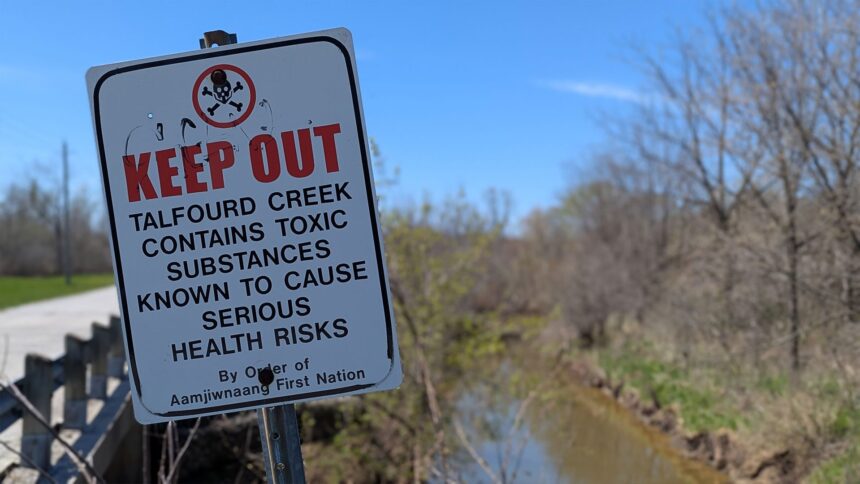
Leave a Comment


